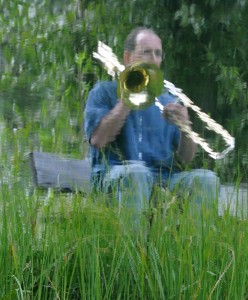Randall Hawes has been the bass trombonist in the Detroit Symphony Orchestra since 1985, after a two year stint in the Woody Herman Orchestra. He performs regularly with chamber music groups formed from members of the Detroit and Chicago Symphonies, and his occasional performances have included the likes of the: Chicago Symphony, Los Angeles Philharmonic, World Orchestra for Peace, Boston Symphony Orchestra and Pittsburgh Symphony.
Orchestra since 1985, after a two year stint in the Woody Herman Orchestra. He performs regularly with chamber music groups formed from members of the Detroit and Chicago Symphonies, and his occasional performances have included the likes of the: Chicago Symphony, Los Angeles Philharmonic, World Orchestra for Peace, Boston Symphony Orchestra and Pittsburgh Symphony.
Since 2004, Hawes has served on the trombone faculty at Northwestern University along with Michael Mulcahy, later to be joined by Timothy Higgins and Douglas Wright. Together they (and formerly NU colleague Peter Ellefson), form the NU Faculty Trombone Quartet. This quartet has been featured at the Pokorny Low Brass Seminar hosted by the University of the Redlands, and in recital. Hawes’ solo albums include: Melodrama and newly released Barnburner. We at davidbrubeck.com are excited to present Randall Hawes as the fourth installmant of year two for Seven Positions.
 First position:
First position:
What do you look for in an instrument?
I’ll have to say that I look for an instrument that can respond tomy efforts to get the sound that I am looking for, an instrument that responds at all dynamic ranges and projects the way I’m used to it
projecting. I have had my travels through all kinds of equipment in the last 35 years, both dependent and independent: a Holton, a Bach with Thayer valves, a few nice old horns that I found on ebay (including a post-war, Soviet Germany f-bass!), and now a Greenhoe independent with Bach bells. I’m always curious to try new stuff, though. I’ve heard great things about the Courtois, so I hope to try those sometime!
Second position:
How do you conceive of an ideal tone quality?I am constantly searching for that elusive thing. Maybe I’ll getthere someday. The sounds that were put in my ears long ago of my heroes;Edward Kleinhammer, Raymond Premru and George Roberts, keep me striving to match their clarity,  projection, beauty and warmth. I believe the instrument is my partner in this search but most of the ideas for the ideal come from within and the sounds that I continue to feed my brain.
projection, beauty and warmth. I believe the instrument is my partner in this search but most of the ideas for the ideal come from within and the sounds that I continue to feed my brain.
Third position:
What is your secret to a beautiful legato?
If only we could bottle it and sell it. To quote Jeffery Reynolds in his new book, A Comprehensive Workbook for Bass Trombone and Tenor Trombonewith F-attachment, “Your slide arrives before the note sounds”. (SlideAhead) This idea helps me, but also thinking of the unending air that
carries one note to the next. To avoid the ‘twa’ of messy legato, you first
have to hear it yourself, then work to get the tongue out of the way. Fast arm, flexible, shock absorbing wrist.
Fourth position:
What helps you achieve musical expression?
Listening to singers and other musicians and mimicking them. I’ll always try to have an active musical line so it doesn’t become stagnant. Playing art songs is a good way to practice musical expression. You can have
the most technically competent player and it can be unmusical.
Fifth position:
Name two inspirations. One musical. One non-musical.
Just two??
Yo Yo Ma, who never ceases to amaze and inspire with his
beautiful playing, his constant creative exploring and his passion for music.
Ansel Adams, who created beauty with his photography and could tell a story
with one photograph. That should be our goal; to tell stories.
Sixth position:
What unexpected surprises have you encountered as you journey to become a bass trombone soloist? About the instrument and the way people perceive it and about yourself?
Well the journey to be a musician has been a great adventure, traveling more than I could ever dream and meeting artists from all over the world who love to create.
I love changing people’s ideas about the trombone and show that it is not always a heavyweight in the back of the orchestra and can be just as expressive and ‘soloistic’ as any other instrument.

Seventh position:
What is it like to teach in a team studio, where students sign up for various teachers? How have your colleagues and the quartet influenced you? At Northwestern, the students rotate to the different teachers and each bring in a lesson summary of their previous week’s lesson to the current week’s teacher. They are required to record the lessons. We (the teachers) are able to get a very good profile of each student, and we see all of the lesson summaries. I have learned as much as the students; as each teacher approaches each problem and unique student differently.
Playing in a quartet is one of the joys of trombone playing, I think. It’s chamber music and is so healthy to do outside of the orchestra job. To play chamber music makes me a better ensemble player in the orchestra or anywhere else, and to play with other great trombonists in a quartet helps to set the
bar higher for me as a musician.
T1
What is the best trombone playing you have ever heard?
That is difficult, there are so many.
Any of the Nelson Riddle recordings with George Roberts are favorites of course.
One CD that many people might know is the Stuart Dempster recording, In the Great Abbey of Clement the VI. This one holds a special place, especially after visiting the Cathedral in Avignon, France and seeing where he played. It is very simple but inspiring.
T2
What is the best trombone playing you have done?
 It’s really not for me to judge, but if you press me, I’m happy with the CD Melodrama, even though it took me years to listen to it; I’ve got some other recordings in the pipeline that I’m happy with and someday maybe they’ll be released.
It’s really not for me to judge, but if you press me, I’m happy with the CD Melodrama, even though it took me years to listen to it; I’ve got some other recordings in the pipeline that I’m happy with and someday maybe they’ll be released.
I find myself playing better when I play with great musicians; better than me. It’s one thing that many musicians have in common, I think. To constantly raise the bar to never be completely satisfied with one’s own playing.
The Detroit Symphony Orchestra recording of Barber’s First Symphony and many of the others with Neeme Jarvi have some great low brass sounds that I’m proud of. I’ve always been impressed how Chandos did a nice job capturing the sound of our nice hall in Detroit.
T3
How can you compare playing in a top jazz outfit like Woody Herman’s Thundering Herd, to a top classical one like the Detroit Symphony Ochestra? What things are shared in common, which aspects are most different? You have good apples, and you have good oranges…Playing in a big band like Woody’s was like chamber music in a lot of ways. Only 13 players, and we all listened to the drummer. There was Woody, who was a nice man. He could be cranky at times, but he had a high standard of how his band should sound-a specific kind of swing.
Woody also had a high standard for behavior too, like when a bass player threw a chair out on the dance floor because Woody wasn’t happy with the way he was playing something…he quit the band in a few days, storming off the bus, walking by Woody muttering expletives. The drummer was a crucial piece of the puzzle, strangely similar to a timpanist in an orchestra; it was often a tough spot to fill. Sound and feel: the timpanist is crucial to the sound of an orchestra; the drummer is crucial to the sound of a big band-same with the principal trumpet and lead trumpet.
In the Detroit Symphony Orchestra, there are 90 of us who are expected to listen and blend. In Woody’s “Thundering Herd”, we listened and blended, too. In Woody’s band I listened for the bari-sax player to hook up with him (as well as the trombone section), on many parts of the music. In the DSO, I key into the sound of the tuba player and blend with the trombones.
Thank goodness the DSO doesn’t tour as much as the jazz band did. Woody’s band would have months and months of constant one-night gigs in marginal hotels with an occasional luxurious, week-long stay in Vegas, New York or San Francisco- while performing run outs or playing at a club.
When the Detroit Symphony tours it’s very posh in comparison; very nice hotels, with everything organized and planned with a very carefully limit on how much the group plays/rehearses/travels.
On the jazz side, the union didn’t really help us out much. We were all reminded that we were dues paying union members, however, when we unknowingly crossed a kitchen workers picket line at the Sands hotel in Las Vegas. We were each sent a scorching letter from the national union condemning what we had done! In the orchestra, the union is very involved. This was most notable during our strike in 2010, when they came to our aid as we were out of work for 6 months.
I now look back at the two years traveling and performing with The Woody Herman Orchestra as sort of a “dues-paying graduate school” for me. I learned so much about the business: how to travel and deal with “road†chops and how to finally have the motivation and experience to put my work into a higher gear in order to win an orchestra job.
These days, I occasionally get my big band “fix†by playing with the Walter White Band. It is a nice, tight group with two trombones, three trumpets, three ‘saxes’ and a rhythm section. Walter White, on trumpet, fronts the band.
c. 2013 David William Brubeck All Rights Reserved. davidbrubeck.com
Interested in more “Seven Positions†tm Interviews?
Charlie Vernon
James Markey
Chris Brubeck
Doug Yeo
Jeremy Morrow
Tom Everett
Gerry Pagano
Ben van Dijk
Randall Hawes
Denson Paul Pollard
Thomas Matta
Fred Sturm
Bill Reichenbach
Massimo Pirone
Erik Van Lier
Jennifer Wharton
Matyas Veer
Stefan Schulz
c. 2013/2014 David William Brubeck All Rights Reserved davidbrubeck.com







































